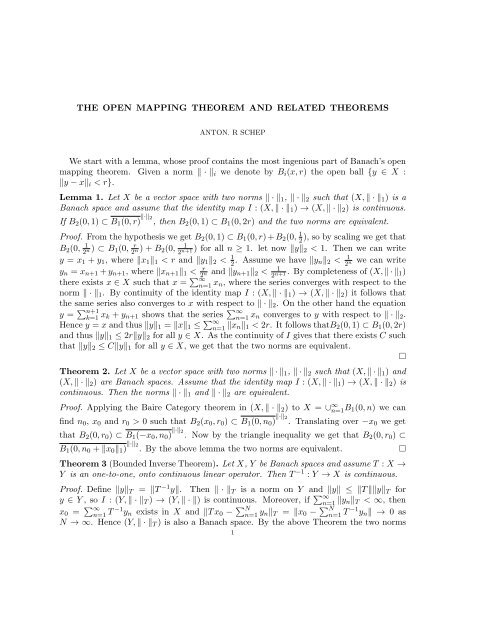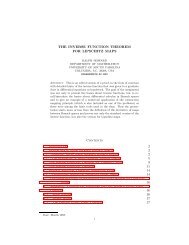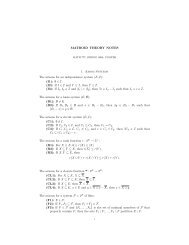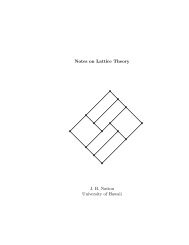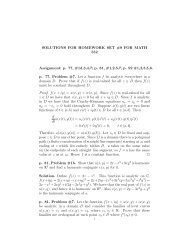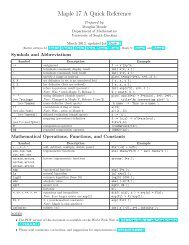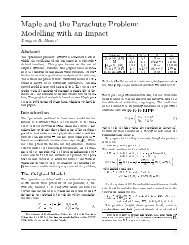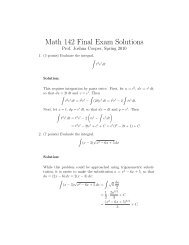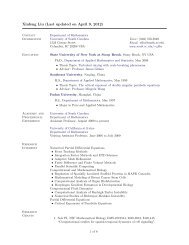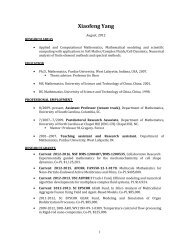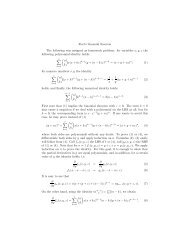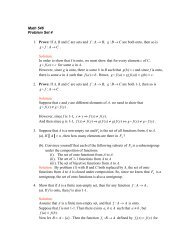THE OPEN MAPPING THEOREM AND RELATED THEOREMS We ...
THE OPEN MAPPING THEOREM AND RELATED THEOREMS We ...
THE OPEN MAPPING THEOREM AND RELATED THEOREMS We ...
Create successful ePaper yourself
Turn your PDF publications into a flip-book with our unique Google optimized e-Paper software.
<strong>THE</strong> <strong>OPEN</strong> <strong>MAPPING</strong> <strong>THE</strong>OREM <strong>AND</strong> <strong>RELATED</strong> <strong>THE</strong>OREMS<br />
ANTON. R SCHEP<br />
<strong>We</strong> start with a lemma, whose proof contains the most ingenious part of Banach’s open<br />
mapping theorem. Given a norm · i we denote by Bi(x, r) the open ball {y ∈ X :<br />
y − xi < r}.<br />
Lemma 1. Let X be a vector space with two norms · 1, · 2 such that (X, · 1) is a<br />
Banach space and assume that the identity map I : (X, · 1) → (X, · 2) is continuous.<br />
If B2(0, 1) ⊂ B1(0, r) ·2<br />
, then B2(0, 1) ⊂ B1(0, 2r) and the two norms are equivalent.<br />
Proof. From the hypothesis we get B2(0, 1) ⊂ B1(0, r) + B2(0, 1),<br />
so by scaling we get that<br />
2<br />
B2(0, 1<br />
2n ) ⊂ B1(0, r<br />
2n 1<br />
) + B2(0, 2n+1 ) for all n ≥ 1. let now y2 < 1. Then we can write<br />
y = x1 + y1, where x11 < r and y12 < 1<br />
2 . Assume we have yn2 < 1<br />
2n we can write<br />
yn = xn+1 + yn+1, where xn+11 < r<br />
2n and yn+12 < 1<br />
2n+1 . By completeness of (X, · 1)<br />
there exists x ∈ X such that x = ∞ n=1 xn, where the series converges with respect to the<br />
norm · 1. By continuity of the identity map I : (X, · 1) → (X, · 2) it follows that<br />
the same series also converges to x with respect to · 2. On the other hand the equation<br />
y = n+1 k=1 xk + yn+1 shows that the series ∞ n=1 xn converges to y with respect to · 2.<br />
Hence y = x and thus y1 = x1 ≤ ∞ n=1 xn1 < 2r. It follows thatB2(0, 1) ⊂ B1(0, 2r)<br />
and thus y1 ≤ 2ry2 for all y ∈ X. As the continuity of I gives that there exists C such<br />
that y2 ≤ Cy1 for all y ∈ X, we get that the two norms are equivalent.<br />
<br />
Theorem 2. Let X be a vector space with two norms · 1, · 2 such that (X, · 1) and<br />
(X, · 2) are Banach spaces. Assume that the identity map I : (X, · 1) → (X, · 2) is<br />
continuous. Then the norms · 1 and · 2 are equivalent.<br />
Proof. Applying the Baire Category theorem in (X, · 2) to X = ∪ ∞ n=1 B1(0, n) we can<br />
find n0, x0 and r0 > 0 such that B2(x0, r0) ⊂ B1(0, n0) ·2<br />
. Translating over −x0 we get<br />
that B2(0, r0) ⊂ B1(−x0, n0) ·2<br />
. Now by the triangle inequality we get that B2(0, r0) ⊂<br />
B1(0, n0 + x01) ·2<br />
. By the above lemma the two norms are equivalent. <br />
Theorem 3 (Bounded Inverse Theorem). Let X, Y be Banach spaces and assume T : X →<br />
Y is an one-to-one, onto continuous linear operator. Then T −1 : Y → X is continuous.<br />
Proof. Define yT = T −1y. Then · T is a norm on Y and y ≤ T yT for<br />
y ∈ Y , so I : (Y, · T ) → (Y, · ) is continuous. Moreover, if ∞ n=1 ynT < ∞, then<br />
x0 = ∞ n=1 T −1yn exists in X and T x0 − N n=1 ynT = x0 − N n=1 T −1yn → 0 as<br />
N → ∞. Hence (Y, · T ) is also a Banach space. By the above Theorem the two norms<br />
1
2 ANTON. R SCHEP<br />
on Y are equivalent, so there exists C such that T −1 (y) ≤ Cy for all y ∈ Y , i.e. T −1<br />
is continuous. <br />
<strong>We</strong> recall now that a linear map T : X → Y is called open if T (O) is open for all open<br />
O ⊂ X. It is easy to see that an open linear map is surjective. The Open Mapping theorem<br />
gives a converse to that statement. Before stating and proving that theorem, we recall a few<br />
basic facts about quotient maps. Let X be a Banach space and M ⊂ X a closed subspace.<br />
Then X/M is a Banach space with respect to the quotient norm [x] = inf{y; y ∈ [x]}.<br />
Denote by Q the quotient map Q(x) = [x]. Then Q is open. In fact, it is easy to see from<br />
the definition of the quotient norm that Q({x : x < 1}) = {[x] : [x] < 1}.<br />
Theorem 4 (Open Mapping Theorem). Let X, Y be Banach spaces and assume T : X →<br />
Y is an onto continuous linear operator. Then T is an open map.<br />
Proof. Let Q : X → X/ker(T ) be the quotient map. Then by the above remarks Q is an<br />
open mapping. Let ˆ T : X/ker(T ) → Y be the induced map such that T = ˆ T ◦ Q. Then ˆ T<br />
is one to one and onto, so by the above Theorem ˆ T −1 is continuous, so ˆ T is open and thus<br />
T is open.<br />
<br />
Let now A : D(A) → Y be a linear operator, where D(A) is a (not necessarily closed)<br />
linear subspace of the Banach space X. The subspace D(A) is called the domain of A.<br />
Given a linear operator A : D(A) → Y we define the graph<br />
Γ(A) = (x, Ax) : x ∈ D(A),<br />
It is clear that Γ(A) is linear subspace of X × Y . <strong>We</strong> can equip X × Y with the product<br />
norm (x, y) = x+y. Then we say that A has a closed graph (or is a closed operator),<br />
if Γ(A) is a closed subspace of X × Y .<br />
Example 5. Let X = Y = C[0, 1] with the supremum norm. Let D(A) = C ′ [0, 1] the<br />
subspace of X consisting of continuously differentiable functions and define A : D(A) → Y<br />
by Af = f ′ . One can can see that A is not bounded, by taking fn(t) = t n , and noting<br />
that fn = 1 and Afn = n. On the other hand A has a closed graph. To see that A<br />
has a closed graph, let (fn, f ′ n) → (f, g) in X × Y . Then by the Fundamental Theorem of<br />
Calculus fn(t) − fn(0) = t<br />
0 f ′ n(s) ds → s<br />
0 g(s) ds. It follows that f(t) = f(0) + t<br />
0 g(s) ds.<br />
Hence f ∈ D(A) and f ′ = g, i.e., (f, g) ∈ Γ(A).<br />
The following proposition is immediate from the definition.<br />
Proposition 6. Let X and Y be Banach spaces and assume A : D(A) → Y is a linear<br />
operator, where D(A) is a subspace of X. Then the following are equivalent.<br />
(1) A has a closed graph.<br />
(2) If xn ∈ D(A), xn → x ∈ X, and Axn → y ∈ Y , then x ∈ D(A) and Ax = y.<br />
(3) D(A) is a Banach space with respect to the graph norm xA = x + Ax.<br />
Theorem 7 (Closed Graph Theorem). et X and Y be Banach spaces and assume A :<br />
X → Y is a closed linear operator. Then A is bounded.
<strong>THE</strong> <strong>OPEN</strong> <strong>MAPPING</strong> <strong>THE</strong>OREM <strong>AND</strong> <strong>RELATED</strong> <strong>THE</strong>OREMS 3<br />
Proof. Define P : Γ(A) → X by P (x, Ax) = x. Then P is clearly a bounded, one-to-one,<br />
onto linear operator, so by the Bounded Inverse Theorem the inverse operator P −1 : X →<br />
Γ(A) is bounded. Hence there exists a constant C such that x + Ax ≤ Cx, i.e.,<br />
Ax ≤ (C − 1)x for all x ∈ X.<br />
<br />
<strong>We</strong> now present a proof of the Uniform Boundedness Principle, based on the Closed<br />
Graph Theorem.<br />
Theorem 8 (Banach-Steinhaus). Let X and Y be Banach spaces and assume Aα ∈<br />
L(X, Y ) (α ∈ F) is a pointwise bounded family of bounded operators, i.e., for all x ∈ X<br />
there exists a constant Cx such that Aαx ≤ Cx for all α ∈ F. Then there exists a<br />
constant C such that Aα|| ≤ C for all α ∈ F.<br />
Proof. Define the space ⊕αY = {(yα) : yα ∈ Y, sup α yα < ∞} with norm (yα) =<br />
sup α yα. It is straightforward to verify that ⊕αY is also a Banach space. Now define<br />
T : X → ⊕αY by T x = (Aαx). Note T x ∈ ⊕αY , since the collection Aα is pointwise<br />
bounded. Clearly T is linear and we claim that T is closed. To see this, let xn → 0<br />
and T xn → (yα). Then Aαxn → yα for all α ∈ F, but also Aαxn → 0 for all α. Hence<br />
(yα) = (0) and T is closed. By the Closed Graph Theorem T is bounded, i.e., there exists<br />
a constant C such that for all x ≤ 1 we have sup α Aαx ≤ C. Hence Aα ≤ C for all<br />
α ∈ F.


